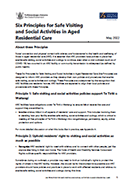Social connection and physical contact with whānau are fundamental to the health and wellbeing of those in aged residential care (ARC). It is essential that ARC providers have policies in place that enable safe visiting, social activities and outings to continue, even when a viral outbreak (such as of COVID-19) has occurred in an ARC facility or community transmission is widespread (as defined by public health).

This publication supports rest home providers in the development of policies and procedures that enable safe visiting, social activities and outings in the context of viruses, such as SARS-CoV-2 which causes COVID-19. These six principles are underpinned by the recognition that ARC facilities are residents’ homes. ARC facilities are expected to align their local policies and procedures with these Principles.They are:
- Principle 1: Safe visiting and social activities policies support Te Tiriti o Waitangi
- Principle 2: Uphold residents’ right to visiting and social activities as much as possible
- Principle 3: Enable visiting and social activities as much as possible while also keeping residents safe
- Principle 4: Consider and respond to the needs of each resident and their whānau
- Principle 5: Keep residents and whānau informed through proactive communication
- Principle 6: Whānau can continue to support residents
The publication describes the intent of these principles in detail and includes an additional appendix focussed on Principle 1.
